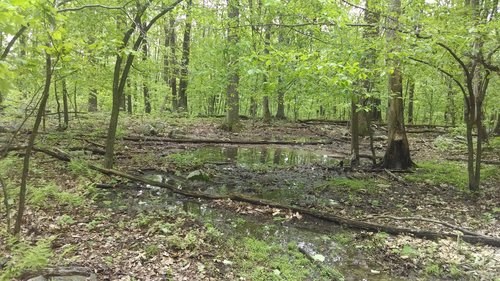The Best Kept Secret at Hawk Mountain
Posted on in On the Mountain by Sean Grace, President
Hawk Mountain and the Kittatinny Ridge are part of a global super-highway for bird migration. If you've been to the Sanctuary during fall, you have probably witnessed the grandeur of diurnal raptors migrating south. Hawk Mountain was the first in the fight to protect these apex aerial predators that are such an important part of a healthy ecosystem, but where does their ecosystem start and stop?

On May 13, I slipped into the woods behind my home which lies at the base of the Kittatinny. I’ve been a naturalist my entire life, and connecting with the land, especially where I live, is vitally important to me. It’s these adventures that help satisfy my desire to understand and immerse myself within my local surroundings. My goal was simple: connect with the land where I live and hike to the top of the ridge. What I discovered along that hike was amazing.
Our woods are under pressure from both man-made and natural disturbance. New homes and other development fragments the forest, and in recent years, the tress here have suffered from repeated assaults by gypsy moths, leaf rollers, and periods of sustained drought. The result is a die-back in some areas of 60% of the chestnut oaks, which provide food in the form of caterpillars for migrating and nesting birds in the spring and act as an important mast crop for many of our resident wildlife populations during colder months.

As I ascended a series of escarpments that were strewn by boulder rubble, I realized that while the boulders make for difficult hiking, they also create a barrier to dissuade development. I also noted many areas where the overstory trees had died back, and beneath the looming skeleton trees, the new regeneration on the ground was the greatest. With death comes life. It was in such an area where I stumbled across what I can only describe as a super-cell of Neo-tropical migrating birds.
In a pocket where the overstory had died back and the understory was almost too dense to walk, I came upon a spot of auditory overload. Never in my life have I heard so many birds call simultaneously. A raptor flew overhead, causing hundreds of birds to drop into the forest surrounding me, in an effort to find refuge.

Hawk Mountain by location is connected to the Canadian Arctic and Alaska down through Central and South America by birds that breed here in North America and over-winter in the southern United States, Central America, and South America. Every moment and every day is different for those birds, and each year they survive the changes, man-made or otherwise, that are created across the landscape where they live.
Our annual raptor migration counts, the longest such record in the world, are just part of our story. We find and collaborate with the best and the brightest young minds in raptor conservation around the globe and invite them to Hawk Mountain to hone their skills as raptor conservation scientists. To date we have worked with 409 trainees from 80 different countries on six continents. These are the people that are shaping global raptor conservation. We continue to collaborate with others and work with all of the significant raptor migration corridors around the globe. In recent months our scientists have been from the Canadian Arctic to South Africa, from Taiwan to the straits of Gibraltar, and our education team has collaborated with colleagues from Zimbabwe, Ghana, and the United Kingdom.

Our main goals include working to keep common raptors common and to prevent rare raptors from becoming extinct. By shining the conservation spotlight on raptors, we help to protect raptors and the ecosystems where they live. Raptors in turn act as an umbrella, protecting other birds and wildlife that live within the same regions where these vital predators live, breed, migrate, and overwinter. Birds, like the hundreds I encountered during my walk, benefit.
This year is being coined the “Year of the Bird,” and Hawk Mountain, by the very nature of the work that we do, is perhaps the most cost-effective organization leading the charge in conservation science. If you share my passion for raptors and other wildlife, I encourage you to become a member, act as a volunteer, or donate in support of Hawk Mountain Sanctuary and our mission. And of course, stop by for a visit! I hope to see you out on that global super-highway of life.
Yours in conservation,
Sean Grace